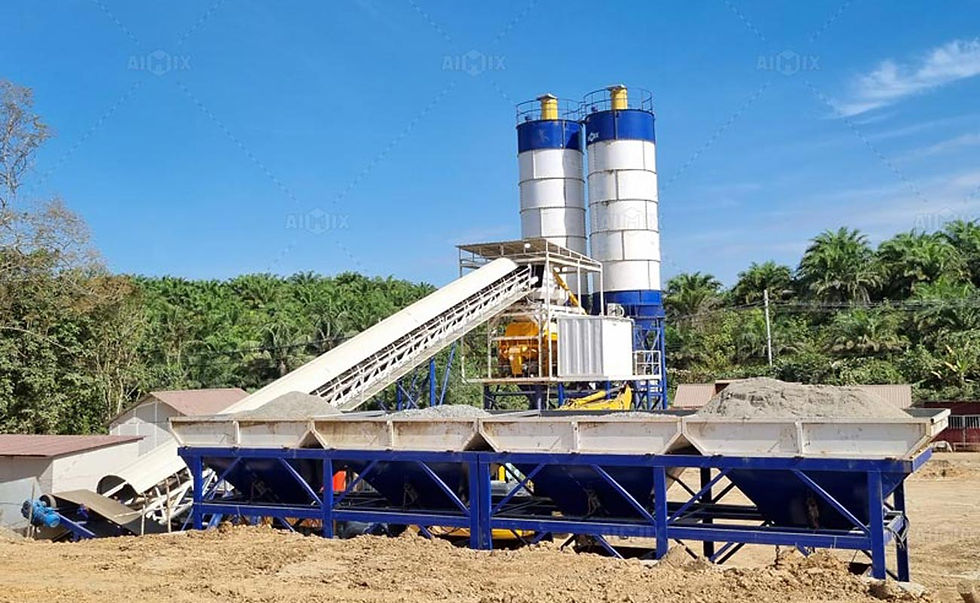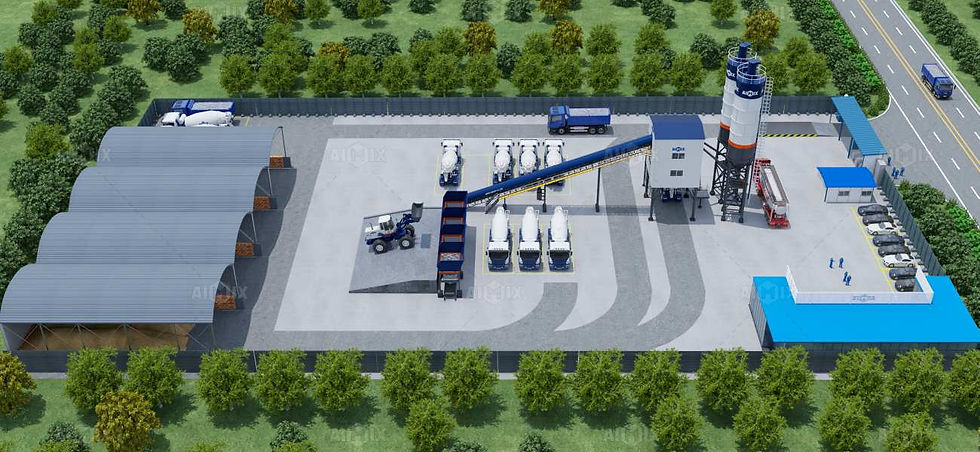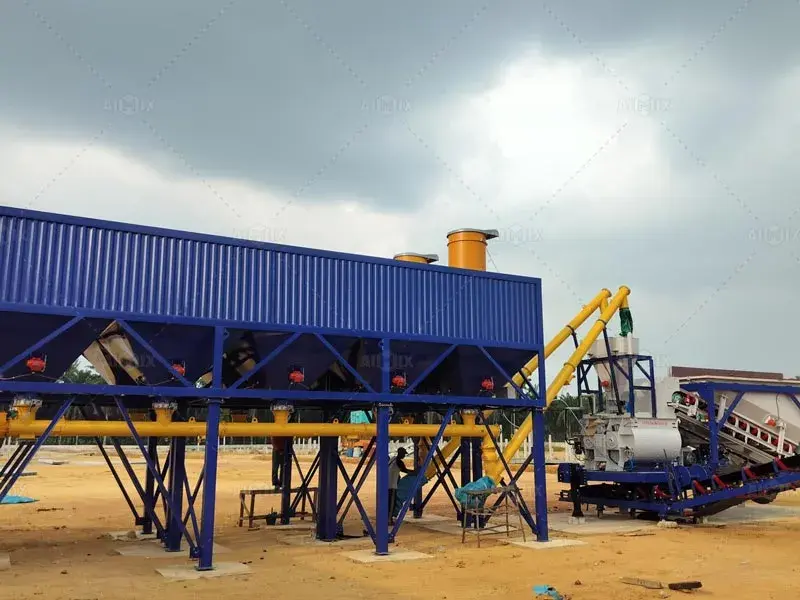Understanding the Components That Drive Batching Plant Prices
- aimixglobal5
- Aug 26, 2024
- 5 min read
When considering the purchase of a batching plant, it's essential to understand the factors that influence its price. The cost of a batching plant isn't just a single figure; it's composed of various elements that can vary significantly depending on the type, capacity, technology, and other specifications of the plant. This article explores the key components that drive batching plant prices, helping you make an informed decision when budgeting for your next investment.
Type of Batching Plant
The type of batching plant is one of the most significant factors affecting its price. Batching plants come in various types, each designed to meet different operational needs:
Mobile Batching Plants: These are portable units that can be easily transported from one site to another. They are generally less expensive than stationary plants but may have lower production capacities and require more frequent setup and breakdown.
Stationary Batching Plants: These are fixed in one location and are typically used for high-volume production. They are more expensive due to the need for permanent infrastructure, such as foundations and utilities, but offer greater efficiency and output.
Compact Batching Plants: These are designed for smaller projects or urban areas where space is limited. They offer a balance between cost and efficiency but may have lower capacities compared to larger, more expensive models.
The choice between these types will depend on your specific project requirements and long-term operational goals.

Capacity and Production Rate
The capacity of a batching plant, usually measured in cubic meters per hour, is another crucial factor influencing its price. Higher capacity plants can produce more concrete in less time, which is beneficial for large-scale projects, but they come with a higher initial cost.
Low to Medium Capacity: Batching plants with lower capacities are suitable for small to medium-sized projects. These plants are generally less expensive but may require longer operating hours to meet project demands.
High Capacity: Plants with higher capacities are designed for large-scale operations and are more expensive. However, they offer significant economies of scale, reducing the cost per cubic meter of concrete produced over time.
When selecting a plant capacity, it’s important to consider both current project needs and potential future demand to ensure you’re investing in a plant that can scale with your business.
Quality of Materials and Components
The quality of materials and components used in the construction of a batching plant directly impacts its price. High-quality plants, while more expensive, are typically more durable and require less maintenance, offering better long-term value.
Mixing System: The type of mixer (e.g., twin-shaft, planetary, or drum mixer) affects both the price and the quality of concrete produced. Advanced mixing systems offer better consistency and faster production times but come at a higher cost.
Control System: The control system of a batching plant can range from basic manual controls to advanced automated systems. While automated systems are more expensive, they increase precision, reduce waste, and can significantly lower operational costs over time.
Investing in high-quality components ensures that the plant operates efficiently and has a longer lifespan, reducing the total cost of ownership. It is important to get a quality and reliable batching plant for good performance and cost saving. Choose a reliable batching plant manufactuer like Aimix Group to get a suitable plant.

Technology and Automation
Technology and automation play a significant role in determining the price of a batching plant. Modern plants equipped with advanced technology are designed to improve efficiency, reduce labor costs, and enhance the quality of the concrete produced.
Automation: Fully automated plants require less manual intervention, which can reduce labor costs and improve consistency. However, these systems are more expensive due to the sophisticated software and hardware involved.
Data Integration: Some batching plants come with data integration capabilities, allowing operators to monitor performance in real-time and make adjustments to improve efficiency. This technology can increase the upfront cost but offers long-term savings through optimized operations.
The level of technology and automation you choose should align with your operational needs and budget, balancing initial costs with long-term benefits.
Installation and Infrastructure Costs
The cost of installing a batching plant and the necessary infrastructure can add significantly to the overall price. These costs vary depending on the type of plant, the complexity of the installation, and the location.
Foundation Work: Stationary plants typically require substantial foundation work, which can be costly. Factors such as soil conditions, site accessibility, and local regulations can influence these costs.
Utility Connections: Connecting the plant to utilities like water, electricity, and waste disposal systems is another expense to consider. In remote or underdeveloped areas, these costs can be significantly higher.
Proper planning and site preparation are essential to minimize installation costs and avoid unexpected expenses.
Maintenance and Operating Costs
While the initial price of a batching plant is important, ongoing maintenance and operating costs are equally critical to consider. High-quality plants often have lower maintenance requirements and can lead to significant savings over time.
Energy Consumption: The energy efficiency of a batching plant can impact long-term operating costs. Plants with energy-efficient designs may have higher upfront costs but can reduce electricity and fuel expenses in the long run.
Spare Parts Availability: The cost and availability of spare parts can influence both maintenance costs and downtime. Plants from reputable manufacturers with reliable supply chains are generally more expensive but ensure that parts are readily available when needed.
Regular maintenance is essential to keep the plant running smoothly and to prevent costly breakdowns, so consider these factors when evaluating the total cost of ownership.

Regulatory Compliance and Environmental Factors
Regulatory compliance and environmental considerations can also affect the price of a batching plant. Non-compliance with local regulations can result in fines, legal issues, and increased operational costs.
Environmental Controls: Plants equipped with environmental controls, such as dust collection systems and water recycling, are often more expensive but necessary for meeting stringent environmental regulations.
Permits and Licenses: Acquiring the necessary permits and licenses can be a time-consuming and costly process. It’s essential to factor these costs into your budget to avoid delays and additional expenses.
Compliance with local regulations not only ensures legal operation but also enhances the company’s reputation as a responsible and sustainable operator.
Conclusion
The price of a batching plant is influenced by a variety of factors, including the type and capacity of the plant, the quality of materials and components, technology and automation, installation and infrastructure costs, maintenance and operating costs, and regulatory compliance. By understanding these components, new buyers can make informed decisions that align with their budget and operational needs. Investing in a batching plant is a significant commitment, but with careful consideration of the factors that drive costs, you can ensure that you’re making a choice that will deliver long-term value and support the growth of your business.







Comments